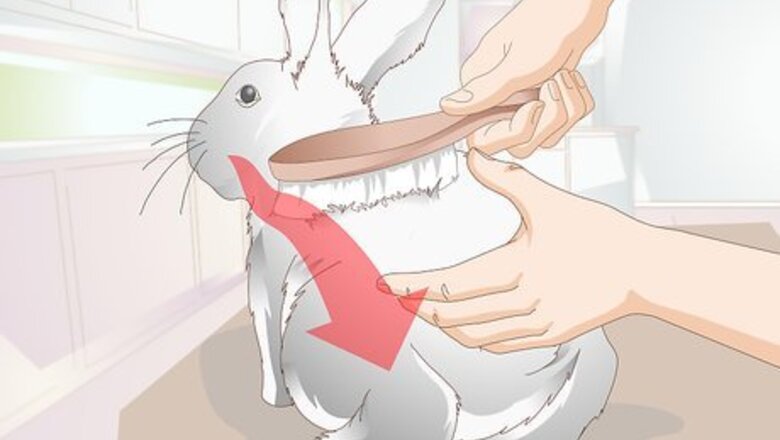
views
Cleaning Your Rabbit Regularly
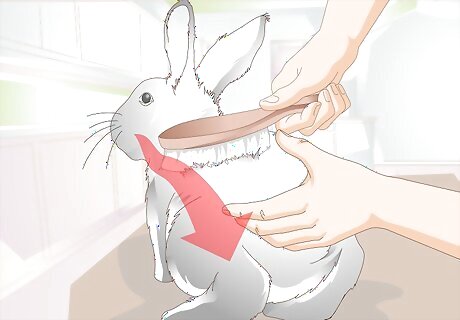
Brush your rabbit regularly. Use a soft brush to run through your rabbit's fur to remove loose hairs as well as dirt and other debris. This will help keep your rabbit's coat looking shiny and new. Plus, rabbits love being brushed, so it can be pleasant bonding time with your pet. After brushing, you may notice small tufts of fur sticking out of the coat. Go ahead and pull them out, your rabbit will not mind. Rabbits will groom themselves regularly, though they cannot vomit like cats, so they are susceptible to hairballs if they swallow too much hair. Removing loose hairs will help prevent your rabbit from choking. Brush more frequently during shedding times, which occur about every 3 months.
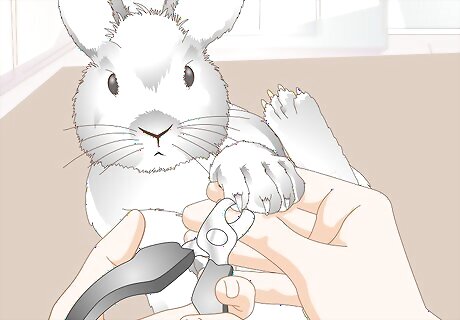
Trim the rabbit's nails. Your rabbit's nails will keep growing, so check them once a week to see if they need trimming. They will probably need to be clipped about every month. Nails that are too long become uncomfortable for the rabbit, and can cause toe, nail, or foot injuries, or gait issues. You can do this on your own with a pair of rabbit nail clippers. Make sure your rabbit is lying on its back with the feet up so they are easy for you to get to, and gently clip the nails on one foot at a time. Make sure your rabbit is secure so it can't kick or scurry away. Once you are finished, you can give your rabbit a treat as a reward. When cutting, a good rule of thumb is to trim the nail to the same length as the fur. Hold up the rabbit's foot, and trim off the edge in one motion. You shouldn't cut a nail more than once. If your rabbit has sensitive nails, and struggles some, lightly close the clippers on the area you wish to cut. If your rabbit reacts, move a little further down the nail and away from the skin. It can be helpful to shine a light underneath the nail so you can see where you are cutting. You don't want to clip the blood vessel at the base of the nail. Baby rabbits will have very sharp, but very small nails. These are probably best trimmed with a emery board instead of the full-size clippers.
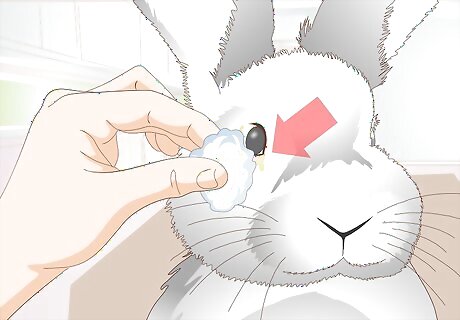
Clean your rabbit's eyes. Watch your rabbit's eyes to keep an eye out for watery eyes or eye discharge. In addition to being a sign of other problems, discharge on your rabbit's cheeks can cause the skin there to become chafed and have the skin peel off. If you notice anything, a clean tissue should be enough wipe this away. Just be careful not to touch your rabbit's actual eye. If there is a lot of gunk, or it seems like your rabbit has a lot of tears, take it to the vet to make sure there isn't a more serious problem.
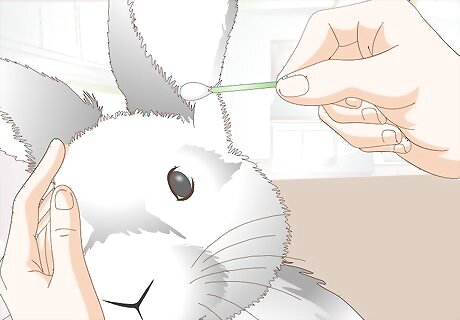
Clean the ears. Check your rabbit's ears for waxy buildup. If you notice any, you can remove it by softly rubbing the ear with a cotton swab. Make sure you don't push the wax into the ear, and do not reach into the ear canal. If you have a problem with wax in the ears, your vet may also recommend some wax removal products that you can apply. Make sure you use a cotton ball and not a smaller swab like a q-tip. If your bunny twitches or jumps during cleaning, you can accidentally push it into the ear, puncturing an eardrum and causing your rabbit to go deaf.
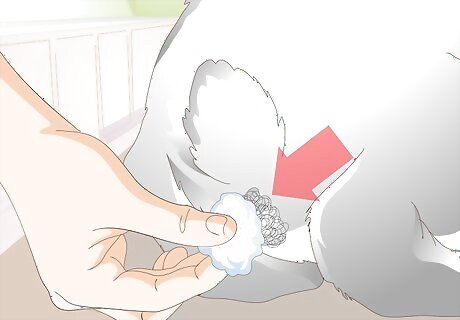
Clean out the scent glands. Rabbits mark their territory using scent glands under their chin and around their anus. The ones on the rear can get some buildup, which can be uncomfortable for your rabbit, and smell. Lay your rabbit on its back to get a clear look at its rear area. Dip a cotton swap into mineral oil or warm water, and gently dab around the gland to loosen the buildup.
Giving Your Rabbit a Bath
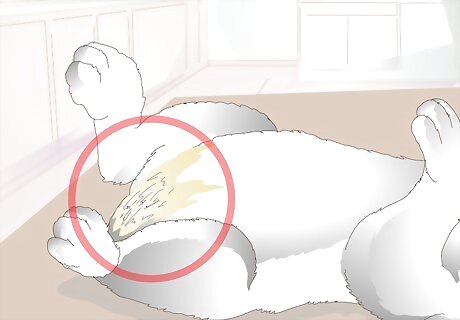
Make sure your rabbit needs a bath. The only time you need to bathe your rabbit is if it has a messy bottom, which comes from having runny stool or urine leakage. The residue on your rabbit's rear is both unsanitary and uncomfortable, and you'll need to bath him to get it off.
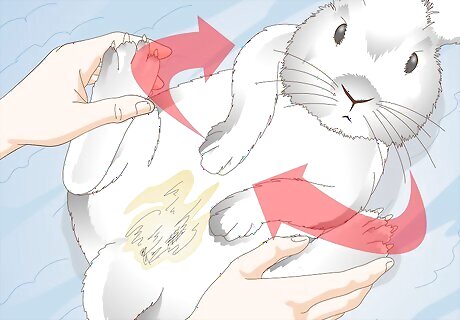
Lay your rabbit down belly up. You'll want to make sure the soiled parts of its rear are easily visible and accessible. The rabbit can be on a bunched up towel sitting on your lap, or lying comfortably on the floor. Make sure you cushion your rabbit's back and neck so that they are well supported in case he decides to start kicking. While your rabbit is lying there, stroke it smoothly and talk soothingly to keep things calm and relaxed.
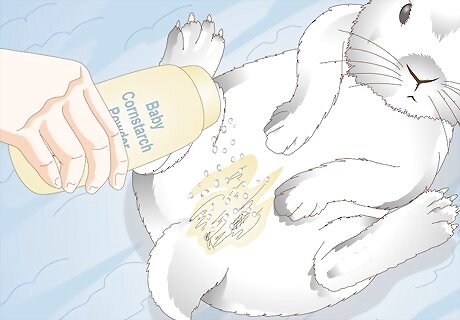
Apply Baby Cornstarch Powder. Put it all over the affected areas, and gently rub it into the messy parts of the fur down to the skin. As the powder coats the dried poop, it should fall out of the skin easily. Do not use powders that contain talc, as it is a respiratory irritant, and can even cause cancer in rabbits.

Brush out the remaining pieces. If there are a few stubborn pieces that rubbing won't get out, use a fine-toothed flea comb to pull them out. Just be careful not to pull too hard, as rabbit skin is very delicate, and can tear easily.
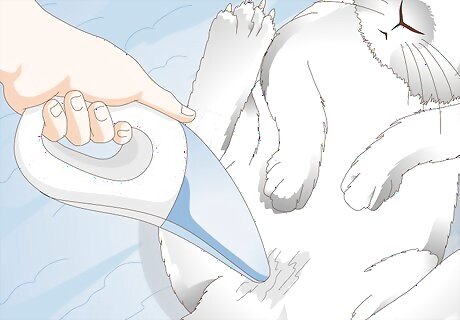
Clean up the remaining powder. Once you are finished, pat your bunny's bottom to get any excess powder off. If you need to, a small handheld vacuum would work too. Use the vacuum to pick up whatever falls off to clean up the area as well.
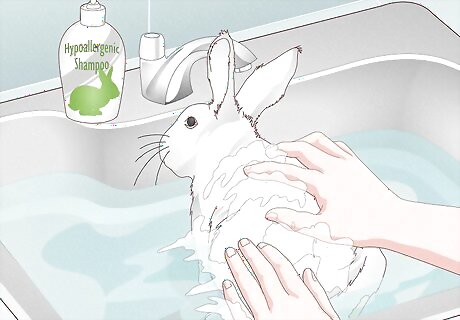
Give your rabbit a wet bath. If the dry bath doesn't do the trick, you'll need to provide a wet bath. This can be a tough procedure, and you will need to be very careful. Rabbits do not like going into water, and can go into shock if they are put into it. Make sure you don't give your rabbit a wet bath unless it is absolutely needed. Fill a bathroom sink or small basin with about 2.5 inches of lukewarm water. Mix in a tablespoon of hypoallergenic, non-medicated shampoo. It is best to get a shampoo specifically intended for rabbits, and not one used on people. Slowly lower your rabbit's rear into the water. Gently wash the solution over the affected areas, then rinse with lukewarm water. Dry off your rabbit's bottom. First use a soft towel, being careful not to rub too hard. Then use a blow dryer set on low to finish drying. Keep one hand close to the rabbit's skin so you can feel if the air is too warm. Clip fur away from the irritated skin, then apply a soothing balm.
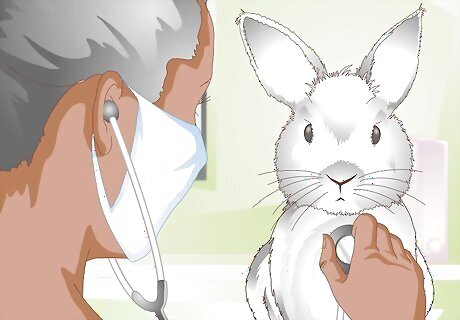
Take your rabbit to the vet. After you have cleaned off your bunny, go to the vet for an examination. Incontinence could be a sign of other health problems, and the vet will need to determine the cause.
Maintaining a Clean Habitat

Create a rabbit habitat. Even if you allow your rabbit to roam freely around your house, it is a good idea to have an area for the rabbit to stay when you are not around. This should be a safe, nesting area, so include a bed, toys, a soft towel or carpet to sit on, and a litterbox. This kind of regular restricted space is also good for cleaning.
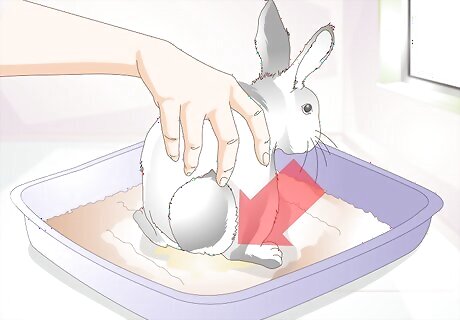
Train your rabbit to use a litterbox. Rabbits are fairly clever and easy to house-train. Get yours to restrict the number of places it goes to the bathroom, which will keep the habitat cleaner, and make clean-up easier for you. Get a small tray with low walls so your rabbit can get into it, and fill with paper or untreated wood chips, then hay. Make sure you keep the tray near places your rabbit usually uses the bathroom so it'll get used the box as a place to go. If you notice your rabbit squatting, carry it over to the box. Remember to clean and disinfect the tray at least once a week. Do not use oil-treated wood chips like pine or cedar, or cat litters.
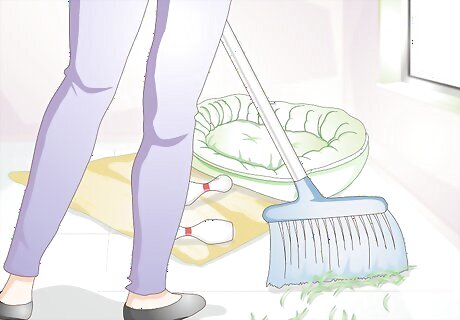
Sweep the habitat floor. Get excess hay, fur, or other items off the floor, which will make a cleaner area for your rabbit to stay in. Throw away the excess stuff to get it out of the room.
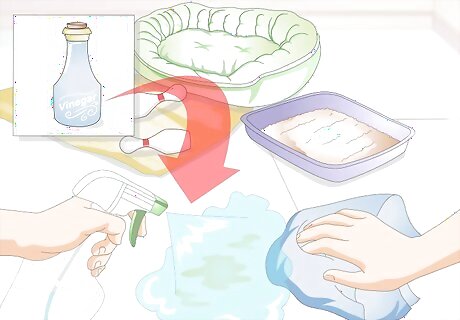
Clean up stains. Look for stains on floors or rugs. If you notice any, use a vinegar spray on the spot, then wipe up with a dry paper towel. If the stains are really set in, or have otherwise ruined the rug, throw it out and replace it.














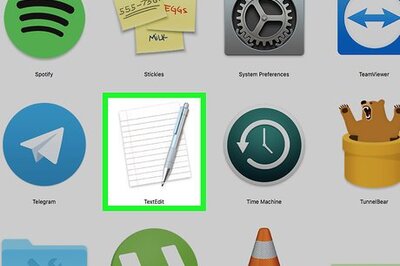





Comments
0 comment